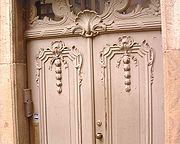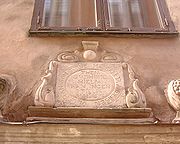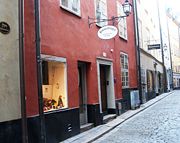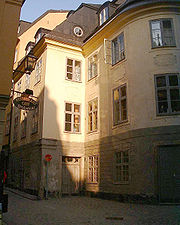
Kindstugatan
Encyclopedia



Gamla stan
Gamla stan , until 1980 officially Staden mellan broarna , is the old town of Stockholm, Sweden. Gamla stan consists primarily of the island Stadsholmen. The surrounding islets Riddarholmen, Helgeandsholmen, and Strömsborg are officially part of, but not colloquially included in, Gamla stan...
, the old town in central Stockholm
Stockholm
Stockholm is the capital and the largest city of Sweden and constitutes the most populated urban area in Scandinavia. Stockholm is the most populous city in Sweden, with a population of 851,155 in the municipality , 1.37 million in the urban area , and around 2.1 million in the metropolitan area...
, Sweden
Sweden
Sweden , officially the Kingdom of Sweden , is a Nordic country on the Scandinavian Peninsula in Northern Europe. Sweden borders with Norway and Finland and is connected to Denmark by a bridge-tunnel across the Öresund....
. Stretching west from Brända Tomten
Brända Tomten
Brända Tomten is a small, triangular public square in Gamla stan, the old town in central Stockholm, Sweden.A few benches under a chestnut tree, the ivy hanging from the surrounding façades makes the space a lush, relaxed spot...
to become Tyska Brinken
Tyska Brinken
Tyska Brinken is a street in Gamla stan, the old town in central Stockholm, Sweden. Extending Kindstugatan passed the German Church down to the square Mälartorget, it is crossed by Skomakargatan, Prästgatan, Västerlånggatan, Stora Nygatan, Lilla Nygatan, and Munkbrogatan, while forming a parallel...
in its western end, it is crossed by Svartmangatan and Skomakargatan
Skomakargatan
Skomakargatan is a street in Gamla stan, the old town of Stockholm, Sweden, Stretching between the square Stortorget and the streets Kindstugatan and Tyska Brinken, it forms a parallel street to Prästgatan and Svartmangatan....
.
Origin of the name
The oldest version of the name — kindhæstagatan (1449), Kindhästegatan (1544) — contains the old Swedish word kindhäst (literally "cheek horse", meaning "box on the ear") but was gradually corrupted to the present name — Kinnestugatun (1667), Kinstugugatan (1709), Kimstagatan (1740), Kimstugatan (1814), Kindstugatan (1847). While the origin of this name is not known, it most likely refers to either a single renown fight or notorious fights giving the area a reputation. As Medieval records knows to tell, curious and striking nicknames was far from unusual, and it possible the street was named after a mansion owned by a man with this name.During medieval times, the street was known as tverru gatu ("Cross Street") as it passed between the eastern city gate
City gate
A city gate is a gate which is, or was, set within a city wall. Other terms include port.-Uses:City gates were traditionally built to provide a point of controlled access to and departure from a walled city for people, vehicles, goods and animals...
(where today is Köpmantorget
Köpmantorget
Köpmantorget is a small public square in Gamla stan, the old town in central Stockholm, Sweden, located between the street Köpmangatan and to slopes collectively named Köpmanbrinken, both of who leads down to the street Österlånggatan...
) and one of the western gates once located where the street changes name to Tyska Brinken.
A walk east to west
The grey building on Number 4, Törnska huset (The Törne House) has two portals; the lintel of the left is from the 17th century while the lower parts are from the 19th century, while the right one, today transformed into a window, used to be the entrance to the backyard. The cartoucheCartouche (design)
A cartouche is an oval or oblong design with a slightly convex surface, typically edged with ornamental scrollwork. It is used to hold a painted or low relief design....
on the building is carrying the message Then Gudh wil hielpa kan ingen stielpa, Anno 1674, Olof Hansson Törne, Margareta Andersen. ("The one God wants to help nothing can overturn", e.g. "God helps those who let him"). The proprietor Törne made a fortune from scratch, became a city mayor, and was finally raised to peerage as Törnflycht. His thirteen children further extended his success story; his sons relieved him as a mayor, became county governors, and even governor general, while his daughter Christina (1673–1752) became the wife of Carl Piper
Carl Piper
Carl, Count Piper was a Swedish statesman. He entered the foreign office after completing his academical course at Uppsala, accompanied Benedict Oxenstjerna on his embassage to Russia in 1673, and attracted the attention of Charles XI during the Scanian War by his extraordinary energy and...
(1647–1716).
The wall anchors on Number 8 reveals the building is from the 1657 which makes it slightly older than the doctor Johan von Hoorn (1662–1724) who lived here. He introduced obstetrics
Obstetrics
Obstetrics is the medical specialty dealing with the care of all women's reproductive tracts and their children during pregnancy , childbirth and the postnatal period...
in Sweden, was a member of the collegium medicum (the physicians organization), and the physician in ordinary to Ulrika Eleonora the Elder
Ulrike Eleonora of Denmark
Ulrika Eleonora of Denmark was the Queen consort of Sweden as the spouse of King Charles XI of Sweden.The name Ulrike is a Danish version of the name; in Swedish she is called Ulrika Eleonora den äldre, which in English means Ulrica Eleanor the Elder), to distinguish her from her daughter, the...
(1656–1693). He published the book The Well-Trained Swedish Midwife (Den Swenska wäl-öfwade JordGumman) in 1697 where he argued against the use of wet nurse
Wet nurse
A wet nurse is a woman who is used to breast feed and care for another's child. Wet nurses are used when the mother is unable or chooses not to nurse the child herself. Wet-nursed children may be known as "milk-siblings", and in some cultures the families are linked by a special relationship of...
s (because they caused infections) and propagated for educating midwifes (something he did free of charge and which to his suggestion was regulated in 1711). He began the development which by the early 20th century had made maternal mortality in Sweden a third that in the US.

Lucidor
Lars Johansson , usually referred to under his pseudonym Lucidor, was a Swedish baroque poet. He is remembered for his burlesque poetry that is seen as foreshadowing that of Johan Runius and, especially, Carl Michael Bellman, and for his dramatic death in a tumultuous brawl at the Fimmelstången...
(1638–1674) was stabbed to death. While Lucidor also wrote hymns and spiritual songs and renewed the genre, he is mostly remembered for his realistic portrayals of inebriety and his famous poem Skulle Jag sörja då vore jag tokot ("I would be a fool to grieve"); the six verses of which one is presented below together with a rough translation:
| Himmelens dagg plär på träden nerdugga, | On the trees heavens dew chooses to drizzle down |
| men så snart jorden har gett dem nog saft | but as soon as earth have given them enough pith |
| att de kunn' trotsa skyn, vem kan kullhugga | to allow them to defy the sky, who can cut down |
| samma, när yxen ens har inte skaft? | the same, when the axe don't even have a shaft? |
| Maskstungne kan man med fingrerna gnugga; | The worm-eaten can be rubbed with the fingers; |
| mången tror vunnit, vad ändlykten taft. | many believes to have attained, what was taken by the tragic end. |
At about 2 am following a boozing evening a night in August, a quarrel between the poet and a Lieutenant Arvid Christian Storm degenerated into a sword duel which ended in the death of the poet.

Rococo
Rococo , also referred to as "Late Baroque", is an 18th-century style which developed as Baroque artists gave up their symmetry and became increasingly ornate, florid, and playful...
estates of the Bourgeoisie
Bourgeoisie
In sociology and political science, bourgeoisie describes a range of groups across history. In the Western world, between the late 18th century and the present day, the bourgeoisie is a social class "characterized by their ownership of capital and their related culture." A member of the...
during that era.
The 19th century façade (at least in style) of Number 18, Brasan ("The Fire") conceals a medieval basement, present under most of the buildings in the neighbourhood, and the fact the building reached its present extent in the end of the 15th century. By the middle of the 16th century, it was occupied by the barber and surgeon Henrik Quant, who had a sandstone relief put on the wall facing Svartmangatan, except carrying his initials and the year 1558, also depicting a monk and a knight blowing on a fire (by many passers-by interpreted as a man and a woman tied to each other by the hell of marriage). The two figures have been interpreted as the Catholic
Roman Catholic Church
The Catholic Church, also known as the Roman Catholic Church, is the world's largest Christian church, with over a billion members. Led by the Pope, it defines its mission as spreading the gospel of Jesus Christ, administering the sacraments and exercising charity...
saint
Saint
A saint is a holy person. In various religions, saints are people who are believed to have exceptional holiness.In Christian usage, "saint" refers to any believer who is "in Christ", and in whom Christ dwells, whether in heaven or in earth...
s Cosmas and Damian
Saints Cosmas and Damian
Saints Cosmas and Damian were twin brothers, physicians, and early Christian martyrs born in Cilicia, part of today's Turkey. They practiced their profession in the seaport of Ayas, Adana, then in the Roman province of Syria...
, patron saints of physicians and pharmacists and the scene is believed to retell the moment when they were tied to a stake because of their faith. Actually it refers to a mediaeval game called Dra Gränja, which was quite popular in Germany and Scandinavia. However, the relief gave name to the property before being relocated to its present spot behind the street door of Number 18.

